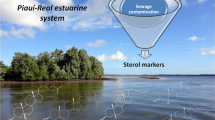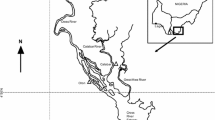Abstract
Sterols were analyzed in suspended particles collected in January 1991 in the Solo River system and in the Serayu River, Java, Indonesia. Free sterols were extracted from particles larger than 0.7 μm and analyzed, after derivatization into their trimethylsilyl esters, by GC and GC/MS. Concentrations of total sterols ranged from 438 to 7922 ng/1, or from 2.4 to 183.8 ng/mg of total suspended matter, which varied from 3.3 to 400 and 471 mg/l, respectively in the Serayu River and at the downstream station in the Solo River. POC concentrations also varied in a wide range, from 0.91 to 4.72 and 6.13% of TSM, respectively at the above stations, and were associated with sterol/POC values ranging from 0.15 to 1.75 μg/mg. Eleven structures of C27, C28 and C29 sterols and associated stanols were identified. 28Δ3,22 was only found at downstream stations in the Solo River and in the Serayu River. This unique distribution, different from that of other C27, C28 and C29 sterols, suggests a predominantly autochthonous origin for these compounds associated with an increased planktonic biosynthesis near the estuary. Concentrations of 28Δ5, 29Δ5,22 and 29Δ5 showed similar spatial distributions and increased downstream, reflecting the significant accumulation of organic matter originating from the vegetation of the various drainage basins.
Values of the autochthonous versus terrigenous sterol index, defined as 27Δ5/29Δ5,22 + 29Δ5 were in the 1.4–1.9 range at upstream stations, whereas at downstream stations lower values were found, 0.4–0.6, which also corresponded to higher concentrations of TSM and lower POC values.
Insofar as the stanol/stenol values can be used to estimate the bacterial activity of oxic waters, simultaneous variations of C27, and C29 stenol/stanol pairs suggest rather different bacterial degradation capacities of autochthonous versus allochthonous organic matter. The wide differencies between the values of the stenol/stanol pairs observed in one of the main tributaries and in downstream stations of the Solo River is evidence that allochthonous organic matter is much more resistant than autochthonous matter. The low index value observed in the Serayu River indicates the highly refractory nature of both autochthonous and allochthonous organic material.
Similar content being viewed by others
References
Bayona JM, Farran A & Albaigés J (1989) Steroid alcohols and ketones in coastal waters of the Western Mediterranean: Sources and seasonal variability. Mar. Chem. 27: 79–104
Boutry J & Barbier M (1974) La diatomée marine Chaetoceros simplex calcitrans Paulsen et son environnement. Mar. Chem. 2: 217–227
Conte MH, Madureira LAS, Eglinton G, Keen D & Rendall C (1994) Millimeter-scale profiling of abyssal marine sediments: role of bioturbation in early sterol diagenesis. Org. Geochim. 22: 979–990
Eyssen HJ, Parmentier GG, Cornpernolle FC, De Pauw G & Piessens-Denef M (1973) Biohydrogenation of stenols by Eubacterium ATCC 21, 408-Nova species. Eur. J. Biochem. 36: 411–421
Gagosian RB (1975) Sterols in the western North Atlantic Ocean. Geochim. Cosmochim. Acta 39: 1443–1454
Gagosian RB (1976) A detailed profile of sterols in the Sargasso Sea. Limnol. Oceanogr. 21: 702–710
Gaskell SJ & Eglinton G (1975) Rapid hydrogenation of sterols in a contemporary lacustrine sediment. Nature 254: 209–211
Grimalt JO & Albaigés J (1990) Characterization of the depositional environment of the Ebro delta (western Mediterranean) by the study of sedimentary lipid markers. Mar. Geol. 95: 207–224
Grimalt JO, Fernández P, Bayona JM & Albaigés J (1990) Assessment of fecal sterols and ketones as indicators of urban sewage inputs to coastal waters. Environ. Sci. Technol. 24: 357–363.
Heftmann E (1971) Functions of sterols in plants. Lipids 6: 128–133
Hoekstra P (1990) River outflow, depositional processes and coastal morphodynamics in a monsoon-dominated deltaic environment, East Java, Indonesia. PhD Thesis, Univ. Utrecht, 215 p.
Huang WY & Meinschein WG (1976) Sterols as source indicators of organic materials in sediments. Geochim. Cosmochim. Acta 40: 323–330
Huang WY & Meinschein WG (1979) Sterols as ecological indicators. Geochim. Cosmochim. Acta 43: 739–745
Kanazawa A & Teshima SI (1971) Sterols of the suspended matter in sea water. J. Oceanogr. Soc. Jpn 27: 207–212
Kanazawa A & Teshima SI (1978) the occurrence of coprostanol, an indicator of faecal pollution, in sea water and sediments. Oceanol. Acta 1: 39–44
Lajat M & Saliot A (1990) Sterol composition of suspended matter from the Changjiang Estuary and adjacent East China Sea. In: Yu G, Martin JM & Zhou J(Eds) Biogeochemical Study of the Changjiang Estuary (pp 642–666). China Ocean Press, Beijing
Lajat M, Saliot A & Schimmelmann A (1990) Free and bound lipids in recent (1835–1987) sediments from Santa Barbara Basin. Org. Geochem. 16: 793–803
Laureillard J & Saliot A (1993) Biomarkers in organic matter produced in estuaries: a case study of the Krka estuary (Adriatic Sea) using the sterol marker series. Mar. Chem. 43: 247–261
Lee C, Farrington JW & Gagosian RB (1979) Sterol geochemistry of sediments from the western North Atlantic Ocean and adjacent coastal areas. Geochim. Cosmochim. Acta 43: 35–46
Matsumoto G, Torii T & Hanya T (1982) High abundance of algal 24-ethylcholesterol in Antarctic lake sediment. Nature 299: 52–54
Matsumoto G, Torii T & Hanya T (1983) Stenols and phytol in lake sediments from Syowa and Vestfold Oases in the Antarctic. Geochem. J. 17: 1–8
Maxwell JR, Mackenzie AS & Volkman JK (1980) Configuration at C-24 in steranes and sterols. Nature 286: 694–697
Nishimura M & Koyama T (1977) The occurrence of stanols of various living organisms and the behavior of sterols in contemporary sediments. Geochim. Cosmochim. Acta 41: 379–385
Pocklington R, Leonard JD & Crewe NF (1987) Le coprostanol comme indicateur de la contamination fécale dans l'eau de mer et les sédiments marins. Oceanol. Acta 10: 83–89
Saliot A & Barbier M (1973) Sterols from sea water. Deep-Sea Res. 20: 1077–1082
Saliot A, Goutx M, Fevrier A, Tusseau D & Andrie C (1982) Organic sedimentation in the water column in the Arabian Sea: relationship between the lipid composition of small and large-size, surface and deep particles. Mar. Chem. 11: 257–278
Saliot A, Andrie C & Marty JC (1983) Environment géochimique organique des sédiments marins récents. Bull. Soc. Géol. France 25: 471–477
Saliot D & Tusseau D (1984) Sterols in interstitial waters of marine sediments. Org. Geochem. 7: 53–59
Saliot A, Brault M & Boussuge C (1988) The lipid geochemistry of interstitial waters of recent marine sediments. Geochim. Cosmochim. Acta 52: 839–850
Saliot A, Laureillard J, Scribe P & Sicre MA (1991) Evolutionary trends in the lipid biomarker approach for investigating the biogeochemistry of organic matter in the marine environment. Mar. Chem. 36: 233–248
Scribe P, Pepe C, Fuche C, Barreau C, Sempere R, Bouloubassi I & Saliot A (1989) Application of the biogeochemical marker approach for determining the inputs and fate of biogenic and anthropogenic organic matter in the Rhone delta: Non-aromatic hydrocarbons and sterols associated to particles. Water Pollut. Res. Rep. 13: 173–178
Scribe P, Barreau C, Pepe C, Fuche C, Dagaut J & Saliot A (1991) Fluvial inputs of organic matter from the Rhone river to the northwestern basin of the Mediterranean Sea: Sterol composition of organic matter. Water Pollut. Res. Rep. 20: 259–267
Sicre MA, Tian RC & Saliot A (1994) Distribution of sterols in the suspended particles of the Changjiang Estuary and adjacent East China Sea. Org. Geochem. 21: 1–10
Tian RC, Sicre MA & Saliot A (1992) Aspects of the geochemistry of sedimentary sterols in the Chang Jiang Estuary. Org. Geochem. 18: 843–850
Volkman JK (1986) A review of sterol markers for marine and terrigenous organic matter. Org. Geochem. 9: 83–99
Volkman JK, Farrington JW & Gagosian RB (1987) Marine and terrigenous lipids in coastal sediments from the Peru upwelling region at 15°S: sterols and triterpene alcohols. Org. Geochem. 11: 463–477
Wakeham SG & Lee C (1989) Organic geochemistry of particulate matter in the ocean: The role of particles in oceanic sedimentary cycles. Org. Geochem. 14: 83–96
Yunker MB, Macdonald RW Veltkamp DJ & Cretney WJ (1995) Terrestrial and marine biomarkers in a seasonally ice-covered Arctic estuary-integration of multivariate and biomarker approaches. Mar. Chem. 49: 1–50
Author information
Authors and Affiliations
Rights and permissions
About this article
Cite this article
Li, W., Dagaut, J. & Saliot, A. The application of sterol biomarkers to the study of the sources of particulate organic matter in the Solo River system and and Serayu River, Java, Indonesia. Biogeochemistry 31, 139–154 (1995). https://doi.org/10.1007/BF00004046
Received:
Accepted:
Issue Date:
DOI: https://doi.org/10.1007/BF00004046




